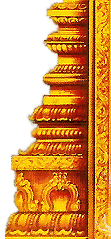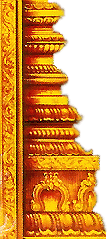Ushath kaala pooja: The sivachariyar should get up in the morning 2 hours before sun rise. He should recite sthothras(divine hymns) by his mouth, Medidate God in his mind and should complete his morning oblutions(Kaalai kadan in Tamil). Then he should take bath in cold water. Wear white dhoti and white upper garment and Rudraksha mala and apply sacred ash. He should do Aasamanam(Taking water in a spoon one after another three times into his mouth. He should then proceed to the temple. He should wash both his hands and legs at the entrance of the temple, worship the Nandhi(divine Bull) and the Dwara balakarkal(Temple ‘s Divine gate keepers) and obtain their permission to enter inside the temple and enter into the temple. He should sprinkle the water on his body and things around him and thus purify them. It should be followed by aathmaarththa pooja(Worshipping one’s own Athma) which include Kara nyasam, Pranayaamam. He should do then Bhootha suddhi, Anthar yaagam, Sivoham bavanai. With these acts the sivachariyar becomes eligible to so Shiva pooja. Then he should receive from the Temple security in charge the keys of Bhairava sannadhi and open the doors of Bhairava sannidhi. He should then worship the Bhairavar and offer him fried grain(Pori in tamil) as neivethyam. He should take from him the keys which were handed over to him the previous night and which was with him till then in his custody. Then all the other sannidhis must be opened with those keys and without disturbing the divine purity of those places(sannithyam in tamil), proceed to the Palliyarai(bed room of the God) accompanied by playing on musical instruements, singing devotional hymns. Then pooja should be performed for the entrance . There after after obtaining the permission of Kaala Kaalan. Medidate the key hole in the form of Bindhu, offer archana to it then put the key in that hole, utter Shiva Manthras and open the Palliyarai doors. Then sprinkle holy water in all places inside the Palliyarai, remove the Nirmalyam(things of the previous day), do in imagination the bathing, offer aasamaneeyam water and stand outside the Palliyarai requesting the God to get up and come outside. Then the Padukas of the Lord should be taken in a palanquin , circumambulate and put it in the sanctum sanctorum. There by taking a flower in the hand before the main deity(Moola Moorthi in Tamil) and offer it main Lingam. Then as a part of ushath kaala pooja, purify the floor, worship Bhoo Devi and purify all the worship materials. Then Ganapathi pooja should be done. Then Swami, Somaskandar, Maheswaras, Goddess (ambal) should be worshipped in accordance with divine rule and regulations. The end of this pooja should coincide with sunrise.
THEERTHA SANKRAHANAM, KAALA SAANTHI POOJAI: At the close of Artha sama Pooja, God Shiva will sit in a palanquin and accompanied by music, dance, and playing on musical instruements will reach his Palliyarai(Bed room) . There Ganga who is in the matted hair(Jada makudam) will worship the Manonmani in the Palliyarai and will leave that place very fast. Joining the Ganga once again on the matted hair of Lord Shiva is called Ganga haranam or Theertha sankarahanam. The Sivachariar who got himself purified, will fill up a Golden pot with river water, decorate it with mangoe leaves and coconut will put it on the head of the temple cook and bring it to the temple accompanied by the playing of Nadaswaram and pour the water on the Shiva lingam. This is called Visarjanam. After this only kaala saanthi pooja will begin. First Soorya pooja, Ganesa pooja will be performed. Then he will prepare Panchakavyam(a mixture of cow’s urine,dung,milk, ghee and curd) and perform Dwara pooja, rishaba devar pooja, Vaasthu pooja, Linga suddhi. He will offer neivethyam. There after Devi pooja and Parivara pooja will be done. It will be followed by Nithya Agni Kaaryam(Homam), shri bali, daily ritual/festival. Finally Pooja to Chndikeswarar will be performed.
UCHCHI KAALA POOJAI (Noon Pooja) : Vigneswara pooja, Punyaha vachanam(Purification function), Bootha suddhi, Anthatyajanam,Medidation (Dhyanam), Sthaana suddhi, Vishesa Arkyam, Dravya sothanai, Manthra sothanai, Sivagambhavanai, etc the preparatory poojas will be performed. Then Snaba pooja will be performed . After worshipping the Dwara Baalakaas(the divine gate keepers) enter inside the sanctum sanctorum . Archana will be performed to the Moola Moorthi(main deity) . The the idol will be decorated and aavarana pooja will be done. There after Dhoopam, dheepam will be shown and Neivethyam is offered.Then poojas will be performed to Natesar, Soma skandar and Goddess . In certain temples after this Nithya agni(homam) karyam, Shri bali, Nithyothsavam will follow. As a mark of the closing of the pooja the remanant flowers of Shiva (Caalled Nirnalyam) will be offered to Chandikeswarar.
Saayam Kaala pooja{Evening Pooja}; Pooja s performed at the time of sun set is called Saayam kala pooja.This is also called as Nithya Pradosha Pooja. (Nithya – Naimithiga pradosha poojas will be held at the sun set time on the thirteenth day called Thrayodasi after full moon or new moon day). First poojas for Ganesar and Natarajar. Then Dhoopa, Deepa , Neivethyam are offered to the Moola Lingam(Main deity). Then poojas for soma skandar and other moorthis, including Devi.
Irandam kaala pooja: First Vigneswara pooja. Then in the sannidhi of swami Dwara pooja, Sivoham Bhaavana pooja. There after abhishegam by reciting Vayomavayaabi manthram starting with oil and ending snabanam. There after the idol will be decorated. Dhoopam, Deepam and Neivethyam will be offered. This is followed by Rajopasaram, Devi pooja, pooja for God’s servants pooja(called Parivaara Pooja), Homam(Nithya agni),Nithyothsavam(Daily festival) shri Bali and finally Chandikeswarar pooja.
ARTHTHA JAAMA POOJAI: There is no Dwara pooja. Snabanam, abhishegam for the main deity, decoration, Panchavarana pooja, Neivethyam, devi Pooja, Bhoga sakthi pooja. Then in the Swami’s(God) temple poojas for Chandra sekarar, Sona skandar, Natesar, Main idol, in that order will be performed. Put the curtains join the Moorthi in the Paduka idol, perform pooja. Then the Padhuka will be put in a palanquin and will be kept in the Palliyarai(Bed Room). Then in the Devi’s temple the curtain will be rung. Sakthi or Devi will be incorporated in the Sayanaalaya idol. Then it will be kept on the left side of the Paduka Moorthi. Then Palliyarai pooja. Milk Paayaasam, Vadai neivehyam. Offering of Thaamboolam. Curtain will be rung again. Requesting the God to go to sleep. Devotional songs will be rendered,musical instruments will be played. The doors of the Palliyarai will be closed. Then pooja will be performed to Chandikeswarar, Bhairavar. Keys of the temple will be handed over to Bharava Idol. Then after closing the Bhairava sannadhi, handing over the keys of Bhairava sannidhi to the temple security-in-charge.
TTIME FOR EACH POOJA: Each Nazhikai is 24 minutes. Abhishegam; two naazhikai . Arcahanai: one Nazhikai. Neivethyam: ½ Nazhikai. Nithya agni kaaryam: ½ naazhikai. Nithyothsavam: ½ nazhikai. Dance, Music etc., : one Nazhikai.
NITHYA AGNI KAARYAM: There will be a pit (Kundam in Tamil) in the swami sannidhi. Purified by performing Nirreshanam, Purokshanam, Thaadanam, Apyushanam, the holy water is sprinkled on the pit. Archana is done to the pit by eight types of flowers. Meditate on the Agni, Put the Parithi(Holy sticks) at the proper places in the pit. Meditate and invoke Brahma Vishnu , Ruthra and Eesananon the Parithis and invoke on the steps (Vishtram in Sanskrit) Indra, deities of the eight directions(Dik baalagarkal). Perform archana for them. Offer water. The fire in the pit should be considered as Shiva agni and offer flowers at the centre of the agni. Pour ghee(Aaguthi in Sanskrit) by uttering Pancha brahma manhras. Then offer cooked food for the Parithi and Vishtram{Steps of the Pit}. Take the flowers kept there by using Anjali Muthra and offer it to Main idol. Then utter shamabaratha Manthras (Manthras requesting to pardon) and place the flowers in the Varatha Hastham of th idol.
SHRI BALI; Daily three times or atleast both in the morning and evening (and if this is not possible atleast once in a day) Bali should be offered. While uttering the various names of the Lord (Naamavali in tamil) we say the name followed by Namaha. But in Shri Bali instead of Namaha utter Swaaha. One will carry Bali naayakar(Idol), the cook will carry the cooked food , the sivachariar will carry on one hand water (Arkyam in Sanskrit) and on the other hand a bell. Starting from the Dwara baalakas(Divine Gate keepers) all Bali peeetas, Nandhi, the Maha bali peetam near Dwajasthambam(flag mast) called Pathra Lingam , Thik Baalkargal(deities in each of the eight directions), Bali peetams of all Parivara deities(servant deities o the Lord) water will be sprinkled on each one of them, get it purified by sprinkling the water on them and keep cooked rice balls on each one of them is called Shri Bali.





